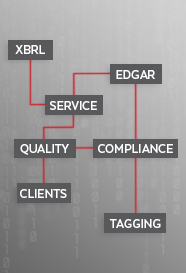XBRL LIMITED LIABILITY EXPIRATION FAQs
When does XBRL limited liability expire?
As the phase-in of detailed-tagging in XBRL continues through 10-K season, the limited liability provision in SEC rule 33-9002 is getting closer to expiration for all companies.
For most companies, this expiration is after one full year of detailed XBRL tagging has taken place. So what does that mean? In the immediate term, very little will change. Long-term, it means the SEC is going to be commenting and requesting further review of XBRL files for completeness, mapping, consistency and structure in accordance with the principles and criteria set by the AICPA.
What are the categories and criteria being looked at in review by the SEC?
These are the four areas that a company should have looked at in depth when properly reviewing XBRL files: completeness, accuracy, mapping and structure of the files. All four areas are included in RDG’s standard Quality Assurance Solution and are the AICPA’s approved guidelines for XBRL review.
Here are some more specifics regarding each section area:
Completeness – Companies will want to have a reporting procedure in place to ensure that all required source information is tagged properly in XBRL. Should any items be missed, the responsibility will ultimately reside with the person in charge of preparing the document and it will be their responsibility to rectify the omission. RDG’s Quality Assurance team has the expertise and experience to shoulder this responsibility and lets our clients rest easy knowing that we can meet any agreed upon procedures your company has.
Mapping – Software programs can and do assist in XBRL mapping quarter over quarter, as well as with searching for proper elements, but the final decisions on concepts, parentheticals, extensions and dimensions will always be subjective and the responsibility of the XBRL preparer(s). RDG already understands this mapping responsibility as part of our XBRL tagging process for our customers and works in tandem with reporting teams to determine the most specific tag for each line item, fact, and significant accounting policy that is required to be tagged. This should be a core competency of any XBRL provider as the SEC considers mapping to be the most critical part of the XBRL Quality Assurance process. There is no “magic-bullet” software tools that can detect this type of error prior to filing, as this core process can be subjective: choosing the narrowest tag and assessing materiality can be an art rather than a science.
Consistency – This will never be completely automated because it requires the human element of understanding a company’s industry and utilizing judgment for concept selection. Even though simple data-quality issues, like negative values can be flagged by software tools, all corporate filers will need to assess the accuracy of financial facts and the specific circumstances each comparative quarters and year-to-date periods.
Structure – Technical validation of errors in the structure are relatively standard to automate and are part of RDG’s validation process and the reports it provides to clients. RDG utilizes a three tiered system of third-party SEC and EDGAR validation tools as well as live-CPA review prior to submission to the SEC.
Are there penalties or consequences for XBRL data errors?
There is no current requirement for attestation by an auditing firm, but validation of XBRL data will be reviewed and questioned by the SEC when limited liability expires. As announced at the 2012 XBRL US Conference in Austin, TX, the SEC has already crafted 290+ comment letters regarding XBRL filings and that number is only going to rise.
How can we avoid XBRL data errors?
Whether you outsource the tagging or prepare the documents in house, the best case scenario is to obtain Quality Assurance from an experienced XBRL tagging provider who knows what to look for in terms of Mapping, Completeness, Accuracy and Structure. Auditors are not required to sign off on XBRL and are not involved in the tagging process, so their review is more structural in nature. Their reports often times are not going to include the hands on knowledge of a company that has expertise in mapping and the day-in-day-out judgment calls of XBRL creation.
In addition, creating agreed-upon-procedures (AUPs) in a collaboration of your internal SEC filing team and audit committee will help. Even if your audit committee wants to wait-and-see what the SEC adds in the way of compliance rules, parties such as analysts and investors may be seeing your company in a negative light due to poor data quality.
The most frequent errors are typically made by in-house software users who are (unknowingly):
- Including negative values in XBRL;
- Not properly using dimensions – which results in higher and unnecessary extension rates.
- Creating files with old concepts that are not up to date with the most current SEC approved taxonomy
XBRL US says: “In the over 14,900 XBRL submissions to date, over 145,000 data issues have been identified related to the use of the XBRL US GAAP Taxonomy. These inconsistencies include incorrect signs, missing concepts and concepts used incorrectly.“



